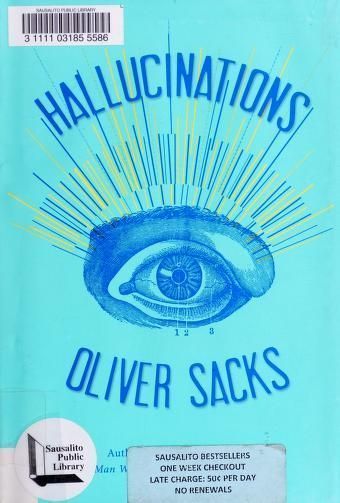
Hallucinations
Have you ever seen something that wasn't really there? Heard someone call your name in an empty house? Sensed someone following you and turned around to find nothing? Hallucinations don't belong wholly to the insane. Much more commonly, they are linked to sensory deprivation, intoxication, illness, or injury. People with migraines may see shimmering arcs of light or tiny, Lilliputian figures of animals and people. People with failing eyesight, paradoxically, may become immersed in a hallucinatory visual world. Hallucinations can be brought on by a simple fever or even the act of waking or falling asleep, when people have visions ranging from luminous blobs of color to beautifully detailed faces or terrifying ogres. Those who are bereaved may receive comforting "visits" from the departed. In some conditions, hallucinations can lead to religious epiphanies or even the feeling of leaving one's own body. Humans have always sought such life-changing visions, and for thousands of years have used hallucinogenic compounds to achieve them. As a young doctor in California in the 1960s, Oliver Sacks had both a personal and a professional interest in psychedelics. These, along with his early migraine experiences, launched a lifelong investigation into the varieties of hallucinatory experience. Here, with his usual elegance, curiosity, and compassion, Dr. Sacks weaves together stories of his patients and of his own mind-altering experiences to illuminate what hallucinations tell us about the organization and structure of our brains, how they have influenced every culture's folklore and art, and why the potential for hallucination is present in us all, a vital part of the human condition. Permissions Acknowledgments Grateful acknowledgment is made to the following for permission to reprint previously published material: American Academy of Neurology: Excerpt from "Anton's Syndrome Accompanying Withdrawal Hallucinosis in a Blind Alcoholic" by Barbara E. Swartz and John C. M. Brust from Neurology 34 (1984). Reprinted by permission of the American Academy of Neurology as administered by Wolters Kluwer Health Medical Research. American Psychiatric Publishing: Excerpt from "Weir Mitchell's Visual Hallucinations as a Grief Reaction" by Jerome S. Schneck, M.D., from American Journal of Psychiatry (1989). Copyright © 1989 by American Journal of Psychiatry. Reprinted by permission of American Psychiatric Publishing a division of American Psychiatric Association. BMJ Publishing Group Ltd.: Excerpt from "Heautoscopy, Epilepsy and Suicide" by P. Brugger, R. Agosti, M. Regard, H. G. Wieser and T. Landis from Journal of Neurology, Neurosurgery and Psychiatry, July 1, 1994. Reprinted by permission of BMJ Publishing Group Ltd. as administered by the Copyright Clearance Center. Cambridge University Press: Excerpts from Disturbances of the Mind by Douwe Draaisma, translated by Barbara Fasting. Copyright © 2006 by Douwe Draaisma. Reprinted by permission of Cambridge University Press. Canadian Psychological Association: Excerpt from "Effects of Decreased Variation of the Sensory Environment" by W. H. Bexton, W. Heron and T. H. Scott from Canadian Psychology (1954). Copyright © 1954 by Canadian Psychological Association. Excerpt from "Perceptual Changes after Prolonged Sensory Isolation (Darkness and Silence)" by John P. Zubek, Dolores Pushkar, Wilma Sansom and J. Gowing from Canadian Psychology (1961). Copyright © 1961 by Canadian Psychological Association. Reprinted by permission of Canadian Psychological Association. Elsevier Limited: Excerpt from "Migraine: From Cappadocia to Queen Square" in Background to Migraine, edited by Robert Smith (London: William Heinemann, 1967). Reprinted by permission of Elsevier Limited. The New York Times: Excerpts from "Lifting, Lights, and Little People" by Siri Hustvedt from The New York Times Blog, February 17, 2008. Reprinted by permission of The New York Times as administered by PARS International Corp. Oxford University Press: Excerpt from "Dostoiewski's Epilepsy" by T. Alajouanine from Brain, June 1, 1963. Reprinted by permission of Oxford University Press as administered by Copyright Clearance Center. Royal College of Psychiatrists: Excerpt from "Sudden Religious Conversion in Temporal Lobe Epilepsy" by Kenneth Dewhurst and A. W. Beard from British Journal of Psychiatry 117 (1970). Reprinted by permission of the Royal College of Psychiatrists. Scientific American: Excerpt from "Abducted!" by Michael Shermer from Scientifi c American 292 (2005). Copyright © 2005 by Scientifi c American, Inc. All rights reserved. Reprinted by permission of Scientific American. Vintage Books: Excerpts from Speak, Memory by Vladimir Nabokov, copyright © 1947, 1948, 1949, 1950, 1951, 1967, copyright renewed 1994 by the Estate of Vladimir Nabokov. Used by permission of Vintage Books, a division of Random House, Inc.
Reviews
Lukas@frightfulhobgob
Laura Mauler@blueskygreenstrees
eris@eris
Astha Prakash@asthaprakash
Cola@theycallmecola
Majd@mowain
Bradley@bradleyjp
Teddy Calavera@teddycalavera
Mt Tetzel@mrzool
MG@marilink
Nargiz Rash@narbertacusa
Deyana@dawndeydusk
Mirella Hetekivi@euphoricdopamine
Nadine @intlnadine
Katie Day@librarianedge
Amanda Gilson@dinkycrow
Angelo Zinna@angelozinna
Kirsten Adam@kcs_adam
Alayna Wiezorek@alaynaclairew
Sander@sander
Amara@darlinglady
Drick@drick
Harsha G@harsha
Gustavo Saiani@gugu